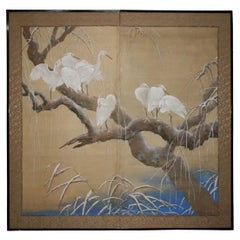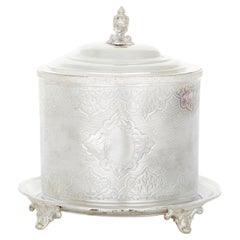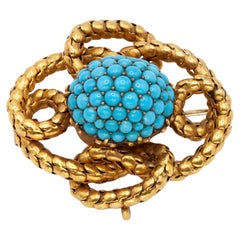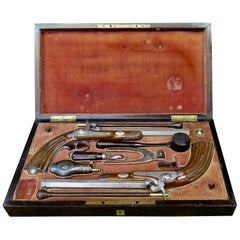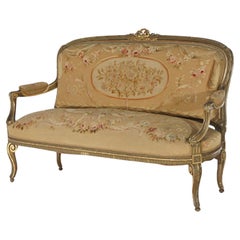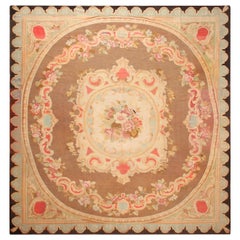New York
to
227
2,111
15,579
9,798
140,013
136,088
66,564
56,510
38,282
22,036
20,173
16,333
13,176
12,586
11,439
9,365
8,252
6,709
6,317
5,834
5,412
3,433
2,752
2,156
2,111
2,027
1,851
1,808
1,374
857
786
604
478
401
348
311
261
239
195
178
176
146
128
116
115
81
66
63
59
58
45
26
20
20
18
12
12
8
8
7
7
7
7
5
4
1
23
11
11
10
9
Period: Mid-19th Century
Period: 1860s
Japanese Two-Panel Screen with Snow Cranes on a Willow Tree, 19th C
Located in New York, NY
This great masterpiece is one of the most amazing screen paintings we have seen, each snow crane is painted with its own personality and attitude, using the finest pigments and Gofun...
Category
1860s Japanese Japonisme Antique New York
Materials
Brocade, Wood
English Sheffield Silver Plate Tea Caddy
Located in Tarry Town, NY
English sheffield silver plate covered biscuit box / tea caddy with exterior design details and finial top cover . The tea caddy / box is in goo...
Category
1860s English Antique New York
Materials
Silver Plate, Copper
Victorian Antique 18K Yellow Gold Turquoise Brooch circa 1850s
Located in New York, NY
A captivating mid 19th century 18K yellow gold cabochon turquoise brooch in richly textured gold. Persian turquoise set over domed setting, surrounded by an intricate gold rope twist...
Category
1850s American Victorian Antique New York
Materials
Turquoise, 18k Gold, Yellow Gold
Vintage Parisian Dueling Pistols
By G. None
Located in Bronx, NY
These vintage early to mid-19th century French percussion cap dueling pistols are presented in their original carrying case. Each is beautifully design...
Category
Mid-19th Century French Antique New York
Materials
Steel
Antique French Louis XV Giltwood & Aubusson Tapestry Sofa C1860
Located in Big Flats, NY
An antique French Louis XV style sofa offers giltwood frame with carved crest over Aubusson tapestry upholstered back and seat, covered scroll form arms and raised on cabriole legs w...
Category
Mid-19th Century French Louis XV Antique New York
Materials
Tapestry, Giltwood
Antique French Aubusson Rug. 14 ft 8 in x 15 ft 2 in
Located in New York, NY
Gorgeous Antique French Aubusson Square Area Rug, country of origin / rug type: French rug, Circa date: 1870’s. Size: 14 ft 8 in x 15 ft 2 in (4.47 m x 4.62 m)
Category
Mid-19th Century French Aubusson Antique New York
Materials
Wool
Antique Quran Book With Manuscripts
Located in New York, NY
An antique Quran book with manuscripts. The hardcover of the book is adorned with embossed traditional ornaments. Circa mid to late 19th century. The Qur...
Category
Mid-19th Century Unknown Antique New York
Materials
Paper
19th Century Large Pair Old Paris Porcelain Vases
Located in Tarry Town, NY
Mid 19th century pair of Old Paris Porcelain decorative vases / urns with exterior gilt gold painted design detail scenes. Each vase featuring two gilt handles and painted scenes of ...
Category
Mid-19th Century French Antique New York
Materials
Gold
Aesthetic Movement Sterling Silver Calling/Business Card Case by George Unite
By George Unite
Located in New York, NY
Aesthetic Movement, sterling silver calling card/business card case in original, velvet lined leather box, London, year-hallmarked for 1860, George ...
Category
1860s English Aesthetic Movement Antique New York
Materials
Sterling Silver
19th Century Grande Sonnerie Vienna Regulator Clock
Located in Tarry Town, NY
Mid 19th century Mahogany wood / glass case grande Sonnerie three weight Vienna Regulator clock. The wall clock features a rosewood veneer with ...
Category
1830s European Antique New York
Materials
Brass
Grand Tour Specimen Marbles Plaque, Italy, circa 1850
Located in Kinderhook, NY
Italian Grand Tour marble specimen plaque in original silver-giltwood frame consisting of 20 different rare and ancient marbles, including Porphyry and Jasper, inlaid into a black an...
Category
Mid-19th Century Italian Grand Tour Antique New York
Materials
Marble
Signed Impressive 19th Century Venice Italy Original Framed Oil Painting
Located in Buffalo, NY
Antique Italian oil painting of Venice. Oil on canvas. Signed. Framed. Image size, 31L x 21H.
Category
1850s Impressionist New York
Materials
Canvas, Oil
Antique Victorian Yellow Gold Carnelian Intaglio Signet Ring
Located in New York, NY
Exuding timeless elegance, this striking ring features a rectangular Carnelian intricately carved with a rare double head. The stone is set in a warm, gold-toned band adorned with de...
Category
Mid-19th Century Antique New York
Materials
Carnelian, Yellow Gold
Blue and White Chinese Vase
Located in New York, NY
Blue and white Chinese vase. Qing era vase modeled in two sections of baluster form in white paste with strong blue figures and accoutrements...
Category
Mid-19th Century Chinese Qing Antique New York
Materials
Porcelain
Zabihi Collection Mid 19th Century Pictorial Balouch Rug
Located in New York, NY
A mid 19th Century Figurative Tribal Persian Balouch worn Carpet
Details
rug no. j4167
size 3' 4" x 5' 10" (102 x 178 cm)
Category
Mid-19th Century Folk Art Antique New York
Materials
Wool
A Pair of 19th Century Meissen Porcelain Figures of a Man and Woman in Attire
By Meissen Porcelain
Located in New York, NY
A Pair of 19th Century Meissen Porcelain Figures of a Man and Woman in 18th C. Attire. This pair of figures depicts a man and woman in 18th-century pastoral attire, each standing on a gilt-accented rocaille base. The woman wears a cream-colored tricorn hat with a floral accent, a fitted blue bodice with detailed buttons and ruffled cuffs, and a flowing skirt with a delicate purple floral pattern. She holds a white cloth in one hand while raising the other in an expressive gesture. Her finely painted features, softly curled hair, and light blue shoes...
Category
1860s German Rococo Antique New York
Materials
Porcelain
Antique French 18 Karat Yellow Gold Cross Pendant
Located in New York, NY
Beautifully designed and masterfully handcrafted this antique cross was made in France ca 1850. Fine azur work and detailed gold work on each edge give this wonderful piece of period...
Category
1850s Antique New York
Materials
18k Gold, Yellow Gold
Late George III Mahogany Bowfront Chest on Chest
Located in Manhasset, NY
19th century late george III Mahogany bowfront chest on chest
A flame Mahogany chest on chest, late 19th century having a lower case suppor...
Category
1860s English George III Antique New York
Materials
Mahogany
1860s French Empire Rosewood Sideboard ( Console )
Located in Tarrytown, NY
1860s French Empire sideboard or console. One side was lightened from the sun as shown in picture.
Category
1860s Antique New York
Materials
Rosewood
Original Nautical Mast figurehead
Located in Sag Harbor, NY
This antique mast figure is French and as the story goes salvaged off a French Ship damaged in the Anglo-French War (1803–1815). The one side shows fire damage and is burned in charc...
Category
Mid-19th Century French Early Victorian Antique New York
Materials
Iron
Mare en foret de Fountainebleau, Barbizon
By Théodore Rousseau
Located in New York, NY
Theodore Rousseau
French, 1812- 1867
Mare en foret de Fountainbleau
Oil on panel
10 1/2 x 16 1/4 inches (26.7 x 41.3 cm.)
Framed: 18 1/2 x 23 1/2 inches (47 x 59.7 cm.)
Signed lower ...
Category
1840s Barbizon School New York
Materials
Oil, Panel
Large Antique Italian Micro Mosaic plaque of St. Peters Square, Rome mid 1800's
By Vatican Mosaic Studio
Located in New York, NY
A Very Large and Exceptionally Fine Quality Antique Italian Micro-Mosaic Plaque Depicting "The Saint Peter Square" in Rome. The center medallion surrounded by a beautiful Laurel Wreath in multiple shades of Green Mosaic amidst a black Belgium Marble border. The interior rounded subject depicts Saint Peter Square which is found in Rome, Italy. The entire center panel is made up of a captivating array of tesserae in a variety of shapes and colors, which create this stunning mosaic construct. When inspected from up-close, small rectangular tesserae are found in an assortment of colors, which include: white, green, blue, red, black, brown, orange etc. When the subject is seen from afar, a fantastic image of the entire Saint Peter Square can be viewed as if a painting has been created. The oil on canvas of this scene, by was sold in Christie's Auction for over $2,000,000 USD. The plaque rests in a custom ebonized and gilt square frame. This can be used as a decorative object on the wall to serve as a painting, or, be converted to a table-top by mounting it on a table stand.
Rome, Circa: 1850
Giovanni Paolo Panini (Piacenza 1691-1765 Rome), View of Saint Peter's Square, Rome.
From Christie's Auction:
Giovanni Paolo Panini arrived in Rome in 1711, painting capricci and architectural pieces in a vigorous if slightly eccentric style, and by 1719, when he was admitted to the Academy of St. Luke and the virtuosi al Pantheon, he was a rising star in the Roman art world. From around 1719-1726 he was much in demand for decorative frescoes, including quadratura, ornament and landscape and other genres, often in collaboration with figure or flower painters. During this period he worked for Cardinal Patrizi at Villa Patrizi, Cardinal Annibale Albani at Palazzo Albani (now del Drago) alle Quattro Fontane, Livio de Carolis at Palazzo de Carolis, Cardinal Alberoni at Palazzo Alberoni, Innocent XIII Conti in the Quirinal and in the library of S. Croce in Gerusalemme. In 1724 he married Caterina Gosset, the sister-in-law of Nicolas Vleughels, the director of the French Academy in Rome, to which he was admitted in 1732, and as a result he was much patronized by the French. During the 1720s he developed his figure style away from the awkwardness of his early works into one that concentrated on groups of stylishly-dressed aristocrats and skillfully modelled bystanders, sibyls and pseudo-antique figures. These he noted down in drawings (such as a sketchbook in the British Museum) that he drew upon to populate his paintings. He also began to receive commissions to design and record temporary festivals, often for French ambassadors to Rome.
By the beginning of the 1730s Panini was developing a distinctive subgenre of the capriccio in which recognizable monuments are placed in imaginary topographical relationships, which were well-received in the classicizing era of Clement XII Corsini. In 1732 he was one of the panel of judges for the competition instituted by Clement for the Lateran façade, and in the following year painted an impressive View of Piazza del Quirinale for the pope. At about this time he was developing his best-known topographical subjects, interior views of St Peter's and the Pantheon, which were much in demand, to judge by the number of extant versions extending into the 1750s. By about 1734 he was beginning to attract the attention of English patrons, who ordered sets of Roman views, such as those at Marble Hill House (1738) and Castle Howard. In 1736, through Filippo Juvarra, he received important commissions from Philip V of Spain for scenes of the life of Christ in the Chinoiserie room at La Granja in Spain (1736). From as early as the 1720s he had been producing some vedute (view-paintings), initially based on prototypes by Gaspar van Wittel, and he developed the genre in subsequent decades in works that would include impressive panoramic views of the Forum or Palatine, although his staple genre was the capriccio rather than the veduta. He also expanded his repertory of church interiors, adding such churches as S. Paolo fuori le Mura and S. Agnese in Piazza Navona, as well as church interiors recording special events. His son by his first marriage, Giuseppe (1718-1805), began to support him in architectural and festival design projects.
By the 1740s Panini was at the peak of his powers, and evidently had a considerable workshop helping him meet demand, especially of capricci to be used as overdoors and other decorative installations. Giovanni Paolo was successful in elevating himself socially above the usual artisanal status of genre painters, and would sometimes include a self-portrait in paintings commissioned by the great and powerful. He also appears to have been successful financially, and owned a substantial palazzo in via Monserrato. He increasingly concentrated on important commissions, such as a view of the Lottery in Piazza Montecitorio (London, National Gallery, 1743-1744), the designs for the festival decorations for the birth of the Dauphin in Palazzo Farnese (Waddesdon Manor, 1751), or the view of an imaginary picture gallery housing the collection of Cardinal Valenti Gonzaga (Wadsworth Atheneum, 1749). In the mid-1750s he received an important series of commissions from the Duc de Choiseul, French ambassador to Rome and soon to become one of the most powerful men in France, that included his best-known compositions, Ancient Rome (Roma Antica) and Modern Rome (Roma Moderna). These large paintings, of which there are three sets (in Boston and Stuttgart, the Metropolitan Museum, and the Louvre) represent imaginary picture galleries based on the Valenti Gonzaga composition but hung with what purport to be Panini's own vedute of ancient and modern sites respectively (with corresponding pieces of sculpture). These paintings sum up the eighteenth-century canon of the greatest works of architecture and sculpture, and the equivalence between modern and ancient Rome. By this time Panini was being assisted by his son by his second marriage, Francesco (1748-1800), who was a skilled draughtsman and painter who continued his father's work after his death in 1765.
The Farnborough Hall paintings
The Piazza S. Pietro and the Campidoglio are important vedute by Panini painted in 1750 and originally installed, with other works by Panini and Canaletto, in the seat of the Holbech family, Farnborough Hall, Warwickshire (National Trust). Farnborough Hall had been inherited in 1717 by William Holbech (circa 1699-1771), who is documented on the Grand Tour in Florence, Rome and Venice from late 1732 until his return home at the end of April 1734 with his brother Hugh. Holbech is said to have gone on the Grand Tour to recover from a broken heart and to have spent a considerable time there prior to these documented appearances. During his time in Rome he acquired two Paninis, which were seen by an anonymous antiquary around 1746, who referred to various sculptures "all brought from Rome with two pictures, one of the Rotunda, and the other of diverse buildings by Panino" (British Library, Add. MS 6230, pp. 31-32). The Rotunda (the Pantheon) is a painting now in a private collection in New York, and is signed and dated 1734. The Diverse Buildings, which was probably one of Panini's capricci, has not been identified. On his Grand Tour Holbech seems also to have acquired two Canalettos, although they are not mentioned by the antiquary, who may only have had eyes for things Roman.
In about 1746-1747, Holbech remodelled the house by creating a Saloon, now the dining room, at the back of the house. This room, the entrance hall, the staircase, library and closet were stuccoed by William Perritt of York, and a bill for this work dated 14 November 1750 survives (or survived until recently; G. Beard, Decorative Plasterwork in Great Britain, London, 1975, p. 233). The two Canalettos acquired on the Grand Tour were installed in the Saloon, together with two new works commissioned from Canaletto, who was then in England and working nearby at Warwick Castle in 1748. The two Paninis acquired on the Grand Tour may have been installed in the Library, as Alastair Laing assumes (op. cit.), while three new works commissioned from Panini in Rome were placed in the Hall and Saloon: the Piazza S. Pietro for the overmantel in the Hall (fig. 1), the Campidoglio as the overmantel in the Saloon (fig. 2), and an Interior of St Peter's (now in Detroit) (fig. 3) on the adjacent wall facing the windows. Two of the Canalettos flanked the Campidoglio, while the others were on the opposite wall. The Interior of St Peter's was therefore effectively the fifth member of the Canaletto set, distinct from the two overmantels.
Holbech's installation of his Canalettos and Paninis in fixed stucco frames was unusual for England in 1750, and had probably been inspired by what he had seen on his Grand Tour in Northern Italy, where fixed stucco installations of canvases were common in the 1720s and 1730s (Cornforth, II, p. 51). The Campidoglio and the Interior of St Peter's are both signed and dated 1750, a date that corresponds to the payments for the stucco.
The commission for the new Paninis would have been made through an agent, possibly the Roman dealer in antiquities Belisario Amidei from whom some of the antique busts in the Hall were acquired in 1745, who was also a picture dealer; or perhaps the painter Pietro Berton, who on 7 December 1750 shipped a Panini to England.
The paintings were sold to Savile Gallery in 1929 and replaced by copies by one Mohammed Ayoub. The four Canalettos were exhibited at Savile Gallery in 1930 and entered the London art trade, finding their way at various times to Augsburg, Melbourne, Ottawa and a private collection. The Paninis seem to have been resold immediately to Knoedler & Co. in New York. When the stucco was removed from the library by Holbech's great-grandson, another William Holbech, shortly after his succession in 1812, the Interior of the Pantheon and the Diverse Buildings may have been taken down. Although there is no record of either painting being at Farnborough subsequently, the Interior of the Pantheon at least must have remained there, since it appeared at Knoedler's in 1930 at about the same time as the other Paninis, and was presumably acquired at the same time from the same source.
The Campidoglio was a rare subject for Panini: this is the only known extant version, apart from fictive versions in the Metropolitan Museum (1757) (figs. 4) and Louvre (1759) versions of his Roma Moderna composition (but not in the first Boston version of 1757). Probably Holbech insisted on the choice of subject in order to represent the centre of Rome's civic administration to complement the religious one of St Peter's. The Campidoglio may have been of interest to English patrons because it represented the seat of a form of government they were more comfortable with than the papacy. For example, Canaletto painted the subject, together with English subjects, for Thomas Hollis, 'the most bigoted of all Republicans' in 1755, who may have wanted to 'represent London as the heir to the legacy of Ancient Rome and Renaissance Italy' (see Michael Liversidge and Jane Farrington, eds., Canaletto and England, exhibition catalogue, Birmingham Museums and Art Gallery, London, 1993, p. 25). Canaletto also painted the subject for Sir Richard Neave, Ist Baronet (1731-1814) of Dagnam Park, Essex, at the end of his English stay or shortly afterwards (i.e. 1755-1766) (sold, Sotheby's, London, 10 July 2002, lot 8). Like Holbech, Neave mixed Venetian and Roman subjects, but his Roman subjects steer clear of St Peter's: the others were the Piazza del Quirinale and Piazza Navona. While Holbech had gone to both Venice and Rome and commissioned views of both cities, Rome sets the keynote for his decoration: antique busts line the Hall, and its religious and civic centres are the overmantels in the Hall and Saloon respectively.
The Piazza S. Pietro
The Piazza S. Pietro shows the piazza much as it appears today, apart from the absence of Valadier's late eighteenth-century clocks on the towers. Bernini's colonnade (1656-1667), both ends of which are visible, reaches out its arms to embrace the viewer. In the center of the piazza is the obelisk moved by Sixtus V in 1586 from the left side of the church where it had formed part of the Circus of Nero. On either side are two fountains, the one on the right by Carlo Maderno (1613) and the one on the left created to match it by Carlo Fontana in 1677. Beyond is the rectangular forecourt to the church, the piazza retta, leading to the façade by Maderno, completed in 1610, and the dome by Michelangelo, Giacomo della Porta and Domenico Fontana. To the right of the façade the roof of the Sistine Chapel is just visible, followed by the Cortile di S. Damaso, the palace of the Swiss Guards and the palace of Paul V. A Cardinal is being driven in a carriage across the piazza at the right in the direction of the Borgo Nuovo and Ponte S. Angelo with his blue-liveried retinue and subsidiary carriages. Unlike the later versions of the subject that depict the Duke de Choiseul, there seems to be no intent to portray any particular cardinal: the procession of a cardinal here is presented simply as characteristic activity within the piazza. Various groups of figures, including well-dressed women in brightly colored dresses, Swiss Guards, priests, gentlemen, idlers and a pilgrim are distributed around the piazza. In the foreground an imaginary heap of fallen masonry provides visual interest in an otherwise dead space.
Panini painted the Piazza S. Pietro on a number of occasions, and his works falls into two types, one with the viewpoint shifted slightly to left of the axis, as in the Farnborough Hall version, and one with it shifted slightly to the right. The first type is based on a composition by Gaspar van Wittel, of which there are numerous versions from 1684 until 1721 (Fig. 9 van Wittel). The work by Panini that seems closest to Van Wittel and therefore probably the earliest is the version in the Circolo della Caccia, Rome, which has been dated to the second half of the 1730s, but is probably a decade or so earlier. Another, on the London art market in 2002-2009, and a version with workshop participation at Sotheby's, Milan (20 November 2007, lot 137) and currently on the art market in Rome, are closer to an important painting in Toledo (Arisi no. 308) that is signed and dated 1741 (fig. 6).
Van Wittel employed a wide format (about 2:1), showed both of the end faces of the colonnade almost to their full extent, and introduced the theme of a heap of masonry to enliven the foreground. His choice of perspective implies a viewpoint located in the small piazza between the Borgo Nuovo and Borgo Vecchio, now the Piazza Pio XII at the top of the Via della Conciliazione. From this viewpoint a building at the left tended to interfere with the view of the end of the left arm, as can be seen from the Nolli map...
Category
1850s Italian Louis XVI Antique New York
Materials
Glass
Louis XVI Dore Bronze Mantle Clock, Conrad Felsing, Berlin
Located in Manhasset, NY
Louis XVI Dore bronze mantle clock, Conrad Felsing, Berlin. A finely cast dore' bronze mantle clock with Sevres porcelain face and decorative pla...
Category
Mid-19th Century French Antique New York
Materials
Porcelain
19th Century Mahogany Wood Federal Sheraton Style Sofa
Located in Tarry Town, NY
Exquisite mid 19th century mahogany wood framed Federal Sheraton style upholstered sofa. The sofa features hand carved in the Sheraton style des...
Category
1850s European Hepplewhite Antique New York
Materials
Upholstery, Mahogany
19th Century Folding Sewing Table with Yardstick Top
Located in Brooklyn, NY
A unique and charming piece of sewing history, this antique wood folding sewing or tailor’s table from the 1800s is perfect for enthusiasts who appreciate the nostalgia and functionality of vintage sewing furniture...
Category
Mid-19th Century Federal Antique New York
Materials
Wood
19th Century French Louis Philippe Style Walnut Chest of Drawers
Located in Astoria, NY
A charming mid-19th century French chest of drawers, crafted in the Grand Louis Philippe style and sourced directly from Provence, France. Expertly handcrafted from solid walnut, it ...
Category
Mid-19th Century French Louis Philippe Antique New York
Materials
Walnut
"Janetta Falls, New Jersey" Jasper F. Cropsey, Hudson River Wooded Landscape
By Jasper Francis Cropsey
Located in New York, NY
Jasper F. Cropsey
Janetta Falls, New Jersey, circa 1846
Signed J.F. Cropsey
Oil on canvas
12½ x 10¾ inches
Provenance
Private Collection, New York, 1930s
Thence by descent to the pr...
Category
1840s Hudson River School New York
Materials
Canvas, Oil
Italian 1940s Pair of Gesso Sculpted Mirrors
By Osvaldo Borsani
Located in CA, CA
An Italian pair of wall mirrors from the 1940s, made of sculpted wood and gesso, cream matt lacquered.
Category
1840s Italian Antique New York
Materials
Gesso, Wood
Zabihi Collection 19th Century Belgian Tapestry
Located in New York, NY
a mid 19th Century Hand-Loomed Belgian Tapestry
Details
rug no. j4363
size 5' 8" x 7' 8" (173 x 234 cm)
Category
Mid-19th Century Asian Vienna Secession Antique New York
Materials
Wool
French Bronze Sculpture of a Stallion, PJ Mene (1810-1871)
Located in New York, NY
This highly detailed study of a Normandy mare is an excerpted model from Mêne's popular Jument normande et son poulain, exhibited in wax at the 1868 Salon (no. 3749), and in bronze t...
Category
1850s French Antique New York
Materials
Bronze
19th Century Mahogany Wood Long Case Clock
Located in Tarry Town, NY
Mid-19th century William Fullerton mahogany wood case long case clock. The case clock is in good antique condition with visible wear appropriate consistent with age / use. The clock ...
Category
Mid-19th Century Antique New York
Materials
Mahogany
Mid 19th Century Chinese Armoire
Located in Brooklyn, NY
Tall armoire in Jumu wood with original red glaze with split storage and two middle drawers
Fitted with brass hardware
Pair of removable doors
Supported by high bracket feet
Category
Mid-19th Century Chinese Antique New York
Materials
Brass
Antique English 19th Century, King Charles Cavalier and Westie dogs in a room
By George Armfield
Located in Woodbury, CT
Antique Victorian English 19th Century, King Charles Cavalier spaniel and Westie terrier in an interior.
This exquisite English 19th-century painting by...
Category
1850s Victorian New York
Materials
Canvas, Oil
Dated 1867, Fine Antique Caucasian Kuba Konaghend Rug, Top Shelf Collectors Rug
Located in Spring Valley, NY
Very fine antique Caucasian Kuba Konaghend rug, dated 1867 AD,
Measures: 4.2 x 5.8 Ft (127 x 174 cm).
Very good condition, no issues. Probably the best...
Category
1860s Azerbaijani Antique New York
Materials
Wool
Tall Opaline Vase Hand Blown and Hand Painted with Flowers, France, Circa 1840
Located in Katonah, NY
We are pleased to offer this opaline vase with beautiful hand painted flowers.
The glass is hand blown, without seams, and is slightly translucent.
The vase is decorated all around...
Category
Mid-19th Century French Louis Philippe Antique New York
Materials
Opaline Glass
Set of three English Porcelain Jugs, circa 1830
Located in New York, NY
Set of three English Porcelain Jugs, circa 1830
Category
1830s Antique New York
Materials
Porcelain
"Mt. Rosalie, Colorado" Albert Bierstadt, Western American Mountain Landscape
By Albert Bierstadt, 1830-1902
Located in New York, NY
Albert Bierstadt
Mt. Rosalie, Colorado, circa 1863
Signed lower left: ABierstadt; inscribed on verso: Mt. Rosalie / Colorado
Oil on paper
13 1/4 x 9 1/2 inches
Provenance
Private Co...
Category
1860s Hudson River School New York
Materials
Paper, Oil
Renaissance Revival Rock Crystal Dragon Pendant
Located in New York, NY
Renaissance Revival Rock Crystal Dragon Pendant-
A rock crystal dragon mounted in 18k gold set with diamonds, a pearl, and rubies
Length: 4.5"
Category
Mid-19th Century Antique New York
Materials
Diamond, Rock Crystal, Crystal, 18k Gold
Mid 19th Century Wood Oars on Stand
Located in New York, NY
Four antique wooden oars, hand-carved in Indonesia, mid 19th Century.
Some original paint is preserved, with time-conferred patina.
The tallest o...
Category
1840s Indonesian Tribal Antique New York
Materials
Wood
Royal Pair of Sèvres Porcelain '1867 Paris Exhibition' Vases and Covers
By Manufacture Nationale de Sèvres
Located in New York, NY
A large pair of ormolu-mounted Se`vres Porcelain Bleu Celeste '1867 Exhibition' vases and covers (‘Vase Paris de Milieu Garnis’), ‘l’Abreuvoir’ and ‘Le Retour’ De Champs’
1860, one ...
Category
Mid-19th Century French Napoleon III Antique New York
Materials
Ormolu
Needlework Biblical Scene Moses Drawn From The River Nile England Circa 1840
Located in Katonah, NY
The Bible story of baby Moses drawn from the River Nile made with silkwork and chenille.
Moses is gently taken from a basket made of reeds while his sister Miriam watches over him.
...
Category
Mid-19th Century English Romantic Antique New York
Materials
Silk
Antique French 18 Karat Two Tone Gold Cross Pendant
Located in New York, NY
Beautifully designed and masterfully handcrafted this antique crass was manufactured in France ca 1850. Detailed work in white and yellow work show blossoms and leaves embellish the ...
Category
1850s Antique New York
Materials
Gold, 18k Gold
Pair of Victorian English Silver Horses
Located in New York, NY
Marked: London, 1847, maker: Robert Garrard.
Category
1840s English Antique New York
Materials
Silver
"The Attack of the Merrimac" Alexander Charles Stuart, Civil War Naval Battle
By Alexander Charles Stuart
Located in New York, NY
Alexander Charles Stuart
The Attack of the Merrimac
Signed lower left
Oil on artist board
13 3/4 x 23 1/4 inches
Alexander Charles Stuart, a Scottish-born painter of ships and marin...
Category
1860s Impressionist New York
Materials
Canvas, Oil
Roman Bust Bronze &Marble Grand Tour Roman Emperor Caracalla, Attr; B. Boschetti
By Benedetto Boschetti
Located in New York, NY
A Large Neoclassical and Exceptional Quality Early to Mid 19th Century Roman (Italian), Grand Tour Bronze and Marble Bust of Roman Emperor "Caraca...
Category
Mid-19th Century Italian Grand Tour Antique New York
Materials
Marble, Bronze
Antique Victorian 14k Gold and Silver Rose Cut Diamond Cluster Earrings
Located in New York, NY
Antique earrings featuring intricate round designs. Crafted with a detailed arrangement of small, sparkling rose cut diamonds set in a circular pattern. The central stone is surround...
Category
Mid-19th Century Victorian Antique New York
Materials
Diamond, 14k Gold, Sterling Silver
Pelvis in the Distance
By (after) Georgia O'Keeffe
Located in Brooklyn, NY
This is a reproduction of Georgia O'Keeffe's painting titled Pelvis in the Distance. Published by the now-defunct Shorewood Fine Art Publications in Connecticut, a renowned publisher...
Category
Mid-19th Century Modern New York
Materials
Offset
Palace Size Antique French Aubusson Rug Charles X Aubusson Oversized Aubusson
Located in New York, NY
About Us~ Welcome to Antique Rug Collection. Your #1 Source for handmade Antique Rugs & Tapestries at great prices, curated by leading industry expert. We are a 6th Generation antiqu...
Category
1830s French Antique New York
Materials
Wool
Pair of Large Chinese Porcelain Rose Mandarin Vases, circa 1840
Located in New York, NY
Pair of large Chinese porcelain rose mandarin vases, circa 1840.
Category
1840s Chinese Antique New York
Materials
Porcelain
Mid 19th Century Chinese Ningxia Rug ( 2' 2" x 2' 2" - 66 x 66 cm)
Located in New York, NY
Mid 19th Century Chinese Ningxia Rug ( 2' 2" x 2' 2" - 66 x 66 cm)
Category
1840s Chinese Antique New York
Materials
Wool
Pair of Wedgwood Borghese Covered Vases, circa 1840
Located in New York, NY
With neoclassical decoration. Impressed Wedgwood.
Category
1840s English Antique New York
Materials
Porcelain
Micromosaic Love Bird Dove Locket Necklace Etruscan Revival Victorian 14k Gold
Located in New York, NY
This is a museum quality Antique Micro-mosaic Locket Pendant finely crafted in high carat gold with a magnificent image of two love birds or doves with flowers on a red background in...
Category
Mid-19th Century Italian Victorian Antique New York
Materials
Gold, 14k Gold, Yellow Gold, 22k Gold
19th Century English Folk Art portrait of a Bull in Maple frame
Located in Woodbury, CT
Anonymous (English School)
Prize Bull Portrait, mid-19th century
Oil on canvas, housed in a figured maple frame
This striking and endearing portrait of a prize bull stands as a test...
Category
1830s Folk Art New York
Materials
Canvas, Oil
Exquisite 19th Century Baccarat Diamond Cut Crystal Barware/Tableware service
By Baccarat
Located in Tarry Town, NY
This rare and elegant 19th-century French Baccarat crystal wine set, crafted in a light ruby pink cranberry color, is a masterpiece of refined luxury and craftsmanship. The set inclu...
Category
Mid-19th Century French Antique New York
Materials
Crystal
English Anglo-Indian Teak and Padauk Center Table
Located in Queens, NY
English Anglo-Indian (mid-19th century) teak and padauk circular table with a filigree apron and pedestal base having intricate foliate and aviary carvings.
Category
Mid-19th Century English Anglo-Indian Antique New York
Materials
Padouk, Teak
"Sunset, Indian Summer" DeWitt Clinton Boutelle, Hudson River School Landscape
Located in New York, NY
DeWitt Clinton Boutelle
Sunset, Indian Summer, 1848-49
Signed and dated lower left
Oil on canvas
12 x 16 inches
DeWitt Clinton Boutelle was born in Troy, New York. He moved to Phil...
Category
1840s Hudson River School New York
Materials
Canvas, Oil
Staffordshire Stag with Fawn Spill Vase England Circa 1860
By Staffordshire
Located in Katonah, NY
This large Staffordshire spill vase features a proud stag with a fawn standing on a shaped base.
The deer are painted in naturalistic orange/brown.
The upper edge of the tree trunk is gilded, and the white base has a fine gilt line.
The piece is decorated mainly on the front (see images).
Ref, 'Victorian Staffordshire Figures 1835-1875' Book 2, by A.& N. Harding, page 243, figure 2911/2912.
Dimensions: 11.75" tall x 7.25" long x 2.75" wide
Condition: Excellent, with very slight rubbing to the gilt on the top of the tree trunk.
Price: $320
Background of Staffordshire Deer...
Category
Mid-19th Century English Country Antique New York
Materials
Pottery
Oversized Antique Karabagh Rug in Black & Red with Floral Patterns - Rug & Kilim
Located in Long Island City, NY
Made with hand-knotted wool and originating in Russia circa 1850-1860, this 8x19 antique Karabagh rug and is a rare extra-long runner and oversized addition to Rug & Kilim’s coveted ...
Category
1860s Russian Antique New York
Materials
Wool
Austro Hungarian Enamel Cross Pendant
Located in New York, NY
Large, attractive Austro Hungarian Enamel Cross Pendant from the mid 19th Century set in silver. Set with turquoise and mother of pearl cabocho...
Category
1860s Hungarian High Victorian Antique New York
Materials
Pearl, Turquoise, Silver, Enamel
Pair of French Porcelain Chinoiserie Figures, circa 1840
Located in New York, NY
Pair of French porcelain chinoiserie figures, circa 1840.
Category
1840s French Antique New York
Materials
Porcelain
